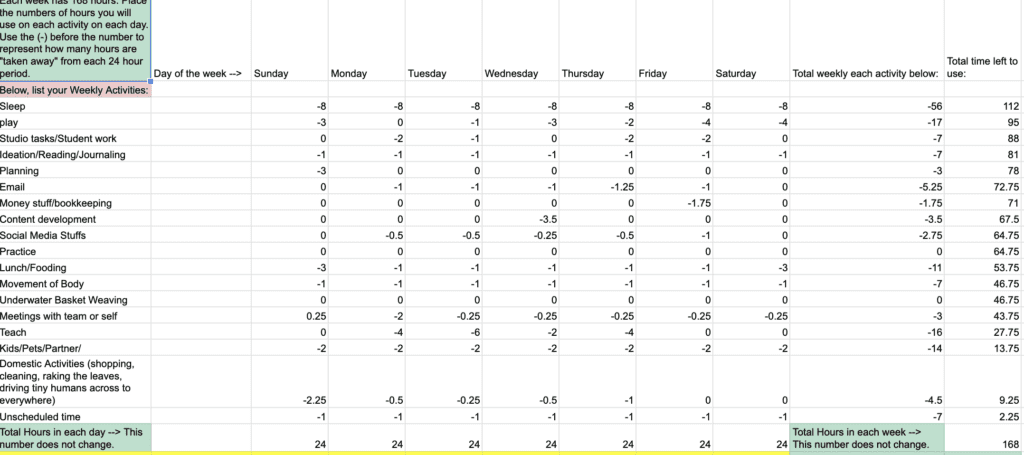Time management is often the hardest part of running your nano-business. You wear all the hats – you’re the CEO, CFO, CMO, and chief service provider. On top of that, you may be the CDO (Chief Domestic Officer), who is responsible for much of the running of a household. Time is of the essence!
You think to yourself, “HOW THE HECK AM I GONNA GET ALL THIS DONE?!” And there are times when the time management list in your head gets so long, that you’re convinced you’ll never accomplish your tasks, let alone manage any projects to fulfill any dreams.
Here’s a little secret: having a realistic understanding of our relationship with tasks, project management, time management, and time will cut your stress in half. At least. Many days, when we are the most overwhelmed, it’s because we are spinning out rather than honing in. That’s where Zero-Based Scheduling comes in.
Learning Zero-Based Scheduling can help you go from overwhelm-ed and underfun-ed to overjoyed and under control.
Just like in financial budgeting, where every dollar has a job, Zero-based scheduling helps you leave every minute with a job – so that you never run out of time for the things you love and want to make a priority.
Let me teach you Zero-Based Scheduling.
Zero-Based Scheduling is a time management tool based on the idea that every minute of your time has a job to do. Because of our western “hard work = value” culture, just the idea of this can be extremely offputting. When I was first introduced to Zero-Based Scheduling, I wanted to run for the hills, because I am a person who very much needs unstructured, unplanned time.
I thought that Zero-based Scheduling would steal this precious time need from me – when in fact – as I learned to do Zero-Based Schedule effectively, it gave me more unstructured, unplanned time. The only difference was that before I had to hope it would “fit in after everything else”, and now, it’s a mandatory part of my week.
In order to begin to use Zero-Based Scheduling for time management, you only need three things:
- A list
- An educated guess on how long things will take you
- A calendar OR a spreadsheet
The List
First, make a list of all the activities you want to plan for in your life. Let’s start small and only do it for the next week.
Be sure to include everything. This is where it gets a little tricky. Usually, we only make lists for things that have to do with “have to’s”. At best, we prioritize work over play and rest. At worst, we view play and rest as a luxury item that can only happen after all work is accomplished.
With Zero-Based Scheduling, all activities are neutral and of equal value, until we assign time to them.
Your list may include time to:
- Sleep
- Play
- Planning work week
- Planning family week
- Cooking
- Eating
- Time with partner/spouse
- Time with kiddos and/or pets
- Client hours
- Bookkeeping
- Moving my body
- Cleaning
- Meal planning
- Shopping
- Driving/travel
- Emails and client communication
- Practicing
- Ideation and Journalling
- Reading
- Knitting
- Watching TV/Movies
- Social Media time – personal
- Social Media time – work
The Educated Guess on the Time Tasks Take
Now that you have your list, you need to determine how long each task will require from you. This is where it can get tricky. We often overestimate the time it takes to do things we hate and underestimate the time it takes to do things we love.
Time is both objective and subjective.
Objectively, we all have 168 hours in a week.
Subjectively, the to-do’s that we have in our 168 hours feel very different in terms of mental output to each of us.
Objectively, my month has the same number of days your month does.
Subjectively, my month may have my usual schedule PLUS six family birthday celebrations, a week of holiday guests, and weekly volunteer stints at the local theater for the run of a show, and yours may be your usual schedule. It varies from month to month.
My 168 hours looks a whole lot different than, say, Beyonce’s, 168 hours. I’ll bet yours does too.
The things that I am required to do for my business, the things I have help getting done, the things I am responsible for in my family, and the things that give me joy, rest, peace, and a sense of accomplishment amount to much different usage of time than Beyonce’s. One is not better than the other – although having a live-in nanny, house manager, and personal assistant would be pretty damn amazing.
When you do your estimates of time, take into account what gives you energy and what takes it away. Give yourself grace around how much you are responsible for in your entire life, not just your business.
Mark Twain once (supposedly) said: If you have to eat two frogs, eat the big one first.
Take this to heart with Zero-Based Scheduling too – if something feels “froggy” be sure to leave plenty of time and space to eat it. Whether your frog is business or personal.
A Calendar or a Spreadsheet of Time and Time Management
If you’re a “Time is on a calendar” person:
Now it’s time to open up your calendar and move your list and it’s appropriate timing into your day.
You’ll mess it up a bit, and that’s okay. If you usually use your calendar for work only things, you may find that you’re doing things in the randomenest nook and crannies of your calendar – laundry for ten minutes here, writing emails for five minutes there, getting the bookkeeping done over six days at 15 minute a day blocks.
As you begin to plan to plan (yes, this is a thing). You’ll get more effective at chunking your time in appropriate ways for your tasks ahead. Just like financial budgeting on a Zero-Based budget takes time to work out, so does Zero-based Scheduling take time to work out.
If you’re a “Time can be chunked up on a spreadsheet” person:
If you prefer to look at your time in terms of blocks – 24 hours in a day that you break up – you may want to use a spreadsheet for a time audit.
Here’s a picture of the one I give to members of the “How to Run Your Voice Business Without Hating Your Boss” program:

What the most important thing to remember at this point is that done is better than perfect. Time is simply there for you to decide what to do with it.
In a way, you can’t get it wrong – you can only learn where adjustments are needed. You will learn them and adjust to them.
Zero-Based Scheduling isn’t a Shitty Manager – it’s a Pepper Potts Style Executive Assistant
People ask me often what I do with my own schedule – how do I manage and plan it.
For day to day planning, I use a BestSelf journal with large post-it notes in it, my Calendar app on my Apple devices, a spreadsheet, a notebook, and when things get really hairy, I have a PDf system I created called the ESS (The Emergency Scheduling System). The attempt to keep it all in one place has never worked well for me, so no matter how efficient this sounds, it works for me.
For quarterly and yearly planning, I use the BestSelf journal, a giant At-A-Glance wall calendar, and a system of questions that I developed to guide clients through quarterly and yearly planning. Yep, I use my own stuff.
However, what I think these people really want to know is how I stick to managing my schedule.
For that, it’s mindset, through and through. Here’s my secret:
My schedule isn’t my manager. It’s my high-level Pepper Potts style executive assistant.
It’s not the thing *I* am beholden to. It does not control me, manipulate me, or demand from me. My schedule doesn’t try to own or shame or attack me and my time management.
My schedule is the executive assistant, and I tell it what needs to get done, and if something needs moving around, it gets moved. She’s SLICK, too – moving meetings, appointments, dinner arrangements all at the whim of my desires… while keeping me accountable to my deadlines.
The Zero-Based Schedule Mindset
The mindset I’d love for you to adopt is thus: I manage (not shittily though!) my Zero-Based schedule, it does not manage me.
Use this technique when you need it, and leave it when you don’t. It’s one of the reasons I love the BestSelf journal. Even though it’s designed for quarterly planning, all the dates aren’t filled in, so you can skip days or weeks if you like.
Put your Zero-Based schedule to work for you. Take rest days, play days, nose to the grindstone days. Take days that are 100% unscheduled time! I don’t care! Simply plan for it and account for it, and let go of any thoughts around “I didn’t finish my list and my day didn’t turn out the way it was supposed to therefore I am a horrible human.”
Try it for two weeks and get back to me… what worked? What needs adjusting? How did your spend your time?
All My BeastyBoss,

Note: If you are a member of The SpeakEasy Cooperative, please ask me about the ESS (Emergency Scheduling System) I’ve created for you and your time management needs. It’s in our member resources, and we can help you find it if you haven’t yet.
P.S. If you’d like to try out the BestSelf company for Zero-based scheduling, use this affiliate link, please. If you wind up purchasing anything, it will kick back a few dollars to me. Consider it buying a friend a coffee to say thank you for the recommendation.
P.P.S I wrote a lot about planning this time last year, too. It’s a tradition! You can check out a blog article on “It’s not the planning, it’s the implementation”, here.






0 Comments